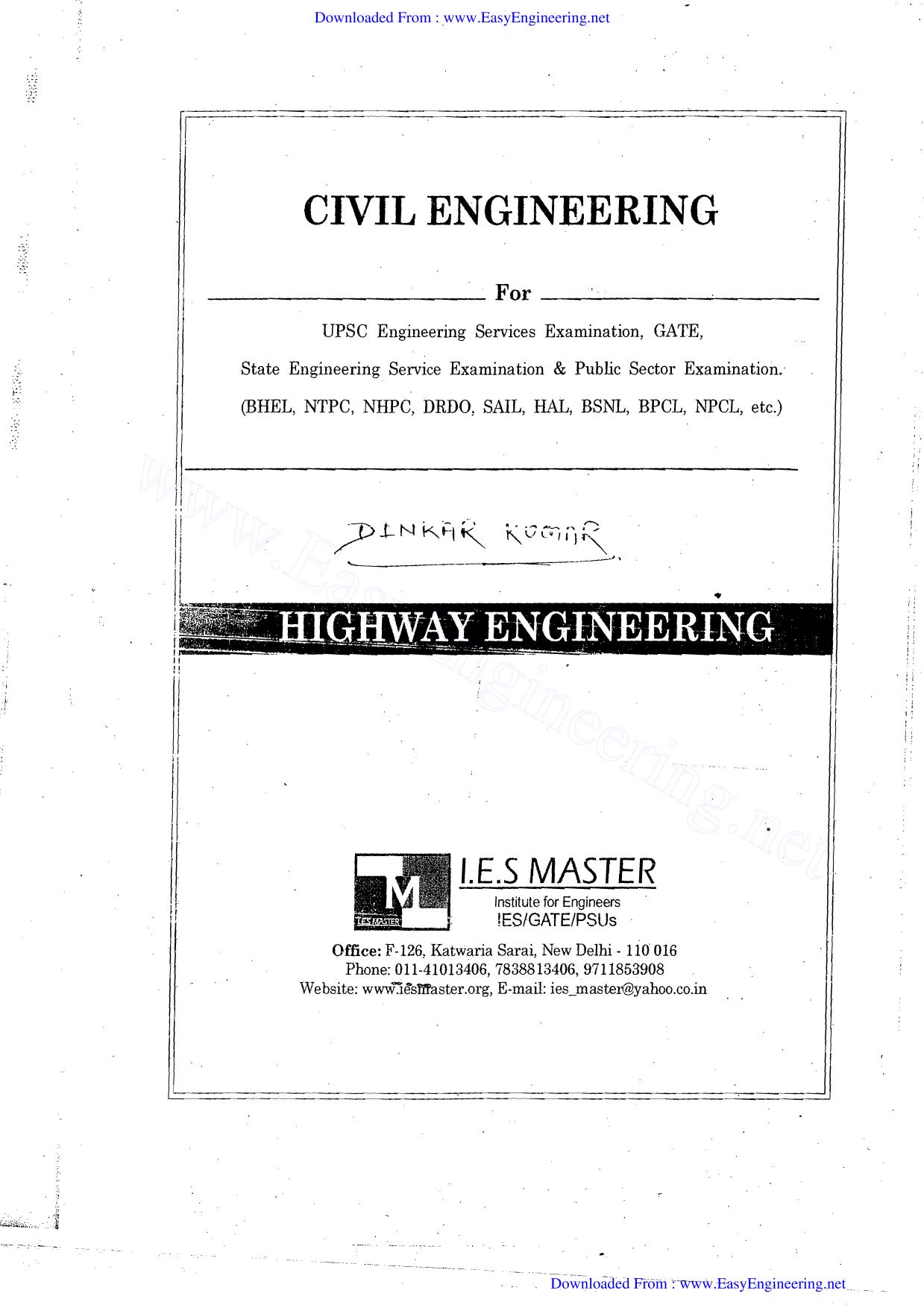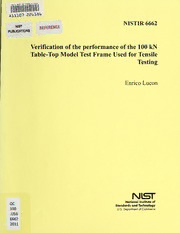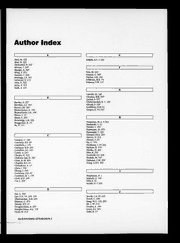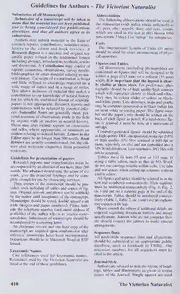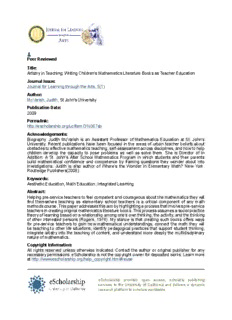
Preview Artistry in Teaching
Peer Reviewed Title: Artistry in Teaching: Writing Children’s Mathematics Literature Books as Teacher Education Journal Issue: Journal for Learning through the Arts, 5(1) Author: McVarish, Judith, St John's University Publication Date: 2009 Permalink: http://escholarship.org/uc/item/31k067sb Acknowledgements: Biography: Judith McVarish is an Assistant Professor of Mathematics Education at St. John’s University. Recent publications have been focused in the areas of urban teacher beliefs about obstacles to effective mathematics teaching, self-assessment across disciplines, and how to help children develop the capacity to pose problems as well as solve them. She is Director of In Addition: A St. John’s After School Mathematics Program in which students and their parents build mathematical confidence and competence by framing questions they wonder about into investigations. Judith is also author of Where’s the Wonder in Elementary Math? New York. Routledge Publishers(2008). Keywords: Aesthetic Education, Math Education, Integrated Learning Abstract: Helping pre-service teachers to feel competent and courageous about the mathematics they will find themselves teaching as elementary school teachers is a critical component of any math methods course. This paper addresses this aim by highlighting a process that involves pre-service teachers in creating original mathematics literature books. This process assumes a social practice theory of learning based on a relationship among one’s own thinking, the activity, and the thinking of other interested persons (Rogers, 1974). My stance is that creating such books offers ways for pre-service teachers to gain new mathematical understandings, connect the math they will be teaching to other life situations, identify pedagogical practices that support student thinking, integrate artistry into the teaching of content, and understand more deeply the multidisciplinary nature of mathematics. Copyright Information: All rights reserved unless otherwise indicated. Contact the author or original publisher for any necessary permissions. eScholarship is not the copyright owner for deposited works. Learn more at http://www.escholarship.org/help_copyright.html#reuse eScholarship provides open access, scholarly publishing services to the University of California and delivers a dynamic research platform to scholars worldwide. McVarish: Artistry in Teaching: Writing Children’s Mathematics Literature Books as Teacher... Artistry in teaching represents high levels of pedagogical performance. Artistry depends on sensibility, it uses imagination, it employs technique, it takes pride in its craft. Teachers as artists are sensitive to the tempo of the classroom, to matters of timing, and to the quality of their own performance and the ways in which it can be shaped to be appropriate for the occasion. Such considerations are in no way prescribable from scientific research. (Eisner, 2003) Helping pre-service teachers to feel competent and courageous about the mathematics they will find themselves teaching as elementary school teachers is a critical component of any math methods course. One way in which I address this aim is to involve pre- service teachers in creating original mathematics literature books. Writing children’s mathematics literature books in the process of learning to teach mathematics assumes a social practice theory of learning based on a relationship among one’s own thinking, the activity, and the thinking of other interested persons (Rogers, 1974). My stance is that creating such books offers ways for pre-service teachers to gain new mathematical understandings, connect the math they will be teaching to other life situations, identify pedagogical practices that support student thinking, integrate artistry into the teaching of content, and understand more deeply the multidisciplinary 1 Journal for Learning through the Arts, 5(1), Article 8 (2009) and complex nature of teaching mathematics. I have found that, via such participation in the process of creating an original story to be used by children to further math learning, pre-service teachers experience the value of aesthetic education as an outgrowth of their own expressions of math concepts. Such reflection and expression enhances “cognitive, perceptual, emotional, and imaginative development …as part of the human effort to seek a greater coherence in the world.” (Greene 2001:7). Mathematics as a body of knowledge is deeply intertwined with human activities. The social experience of learning offers pre-service teachers a way to see themselves in relationship to mathematics methodologies and content, the activities in which they and others are engaged, and their own mathematics learning histories. In so doing, students begin to reconceptualize their notions of the meaning of mathematics and what it means to be mathematically empowered. Children’s literature offers teachers a human perspective on the teaching of mathematics (Whitin & Wilde, 1995). The usefulness of mathematics becomes part of our lives through stories, whether the story is about dividing cookies (“The Doorbell Rang”), measuring a bed (“How Big is a Foot?”), walking on the beach (“Sea Squares”), or eating together (“Eating Fractions”). Ursula LeGuin claims, “The story - from ‘Rumplestiltskin’ to War and Peace - is one of the basic tools 2 McVarish: Artistry in Teaching: Writing Children’s Mathematics Literature Books as Teacher... invented by the human mind, for the purpose of gaining understanding. There have been great societies that did not use the wheel, but there have been no societies that did not tell stories.” Future teachers grow best when they are helped by teacher educators to embrace the complexities of practice and eschew endorsing simplistic pedagogical strategies they are told will solve their classroom problems. As teachers ourselves, we know that teaching is embedded in layers of dilemmas to tackle, as well as unsuspected challenges that call for unprecedented solutions. Researchers identifying key characteristics of successful professional development plans aligned with the Principles and Standards of School Mathematics (NCTM, 2000) specified that teachers need opportunities to study student mathematical thinking (Driscoll & Moyer, 2001; Schifter & Riddle, 2004). The task before us as mathematics educators is complex. It involves helping students to appreciate more fully the notion that teaching is a complex endeavor demanding a multitude of decisions. For example: when to tell or ask, and how to engage and support. Preparing teachers to teach involves more than content and pedagogy overviews. Rather, leading mathematics educators seek to assist teaching neophytes to coalesce a multitude of teaching facets into a whole that resembles more a symphony than disconnected notes. Our role as teachers of mathematics is to help our students to 3 Journal for Learning through the Arts, 5(1), Article 8 (2009) think about student learning in terms broader than right and wrong, to encourage them to ground the learning experience with student interests, to teach math content in meaningful ways, and to help young children to develop mathematics courage and understanding rather than rote compliance. How do we help pre-service teachers embrace teaching as a complex endeavor that sees math content as not what is to be “delivered” in the classroom but is redefined as an interrelationship between the content, the pedagogy and student engagement? For example; geometry is bigger than the study of geometric shapes and Geoboards. Tangrams will not singularly solve the problem of how to teach geometry. Yet many education methods classes often leave students concluding that knowing how to teach with manipulatives is sufficient. Beginning teachers frequently focus on their own teaching practices rather than on what their students are learning. Yet it is asserted that they need to be able to figure out what they do and do not yet understand about how their students are performing and what they might do about it (Entwistle, 1991). They need to be able to ask themselves and others questions to guide their learning and decision- making. In other words, they need to go “meta” about their own practice. The more they embrace the complexities of teaching and 4 McVarish: Artistry in Teaching: Writing Children’s Mathematics Literature Books as Teacher... learning the better equipped they become to shape their teaching to meet the needs of their students. The Process Each pre-service teacher enrolled in one of my mathematics methods courses participates in a multi-step process to craft an original story illuminating at least one mathematics concept. An old Chinese proverb, “Even a nine story pagoda must be built up level by level,” emphasizes a key course philosophy. The book project spans 15 weeks, with assignments and check points throughout the semester. The course syllabus incorporates the following ten-step process that provides an accounting of each step. Student comments, taken from class assignments and self evaluations will be quoted in order to more fully represent the process. Step 1: Choosing a math topic for the book Each student is asked to identify an area of mathematics about which she/he wants to deepen understandings during the semester. This might be an area in which she considers herself weak or possibly a mathematics topic that has always fascinated her. Topics include counting, number sense, equivalent fractions, and positive and negative numbers. 5 Journal for Learning through the Arts, 5(1), Article 8 (2009) Being that as a student teacher I taught multiplication and division to my third graders, it became clear to me that this was the right direction I should go in; therefore I wanted to write my book on that topic. Student Self Evaluation Step 2: Identifying appropriate grade levels for this math topic Students are asked to decide upon a grade level toward which they want to target their story. I encourage the students to choose grade levels in which they have experience or a desire to teach in the future. This helps the students to connect the research about their math topic to the classroom. Step 3: Examining key pedagogy strategies from the Van De Walle text for this grade level and topic. Students use the Van De Walle text to think more deeply about their math topic and the teaching strategies suggested there to help build understanding in this mathematics area. Many students indicate that they have never thought about teaching or learning mathematics in ways that differ from how they were taught. The notion that one might teach meaningful math understandings in formats other than direct instruction is a surprise to many. 6 McVarish: Artistry in Teaching: Writing Children’s Mathematics Literature Books as Teacher... Reading Van De Walle’s section in the text about division helped me think about my topic. He was stressing how important it is to teach multiplication and division closely together so the students can see that the concepts are related. Van De Walle states that ‘words, pictures, and numbers are really important’ when solving problems such as division. I made sure in my book that I not only wrote about a concept of division, but I also used pictures and numbers to visually show what I set out to teach. Student Self Evaluation Step 4: Locating research articles that detail aspects of teaching or learning this topic. Students are asked to locate at least two research articles related to the teaching and learning of the math topic they have chosen. Students are to note what they learned from reading the articles and how this will help them in writing their books. Example 1 Article summary Hands on Subtraction Audrey C. Rule Mathematics Teaching. Derby: June 2005., Is. 191; pg 19, 3 pp. 7 Journal for Learning through the Arts, 5(1), Article 8 (2009) This article discusses the importance of manipulatives when teaching mathematics. Children often struggle with the concept of the operation of taking away. The article shows different ways to perform subtraction without using the operation of take away. Furthermore, it stresses that students should be able to pick and choose their own problems to solve. By using the manipulatives and problem solving on their own, students can return to the problems in the future and discover different ways to solve the same problem. The material that can be used in the problems must catch children’s eyes as well as be colorful and creative. The problem that stuck out to me the most was the gift purchases with coins. I believe that I can use the idea of manipulatives and combine this problem in my book. Since I am gearing the book towards first grade, I think that after reading this article incorporating manipulatives would make the book more appealing. I can attach a Ziploc bag of manipulatives. Example 2 Article: Through the Aesthetic Realism Teaching Method Addition and Subtraction Oppose Prejudice” Colavito, L. (1999). 8 McVarish: Artistry in Teaching: Writing Children’s Mathematics Literature Books as Teacher... In the article Colavito focuses on how students learn mathematics in a way that is friendly to them. “Adding and subtracting are opposites and they are everywhere, including in ourselves.” While I’m writing my book, I’m going to remember to incorporate instances that will be relevant to the lives of the students. Since I’m doing my book on addition, I’m going to focus on the world and environment in which we live. This will give the students an idea about real life situations that in turn may enhance the learning process. One statement in the article made by a child that struck me as interesting was when the teacher asked students how they use math in their everyday lives. A student replied, “We lose baby teeth and grow new ones.” This shows the importance of mathematics in the lives of children and how mathematics can be explored through real life experiences. Example 3 Article: Teaching Addition and Subtraction Facts: A Chinese Perspective Wei Sun, Joanne Y. Zhang. Teaching Children Mathematics. Reston Sep 2001. 9
Description:The list of books you might like

Do Epic Shit

The Mountain Is You

Atomic Habits James Clear

The 5 Second Rule: Transform your Life, Work, and Confidence with Everyday Courage
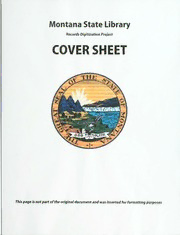
Apprenticeship and training program biennial report for ...
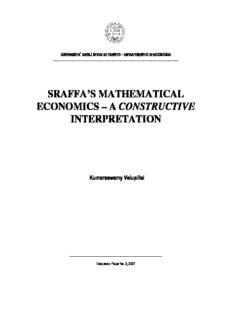
sraffa's mathematical economics – a constructive interpretation
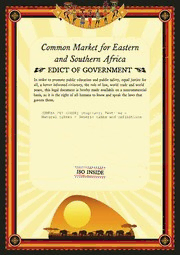
COMESA 261: Textiles - Natural fibres - Generic names and definitions
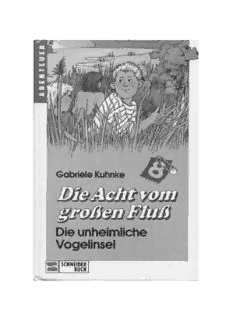
Die Acht vom großen Fluß II. Die unheimliche Vogelinsel. ( Ab 10 J.)
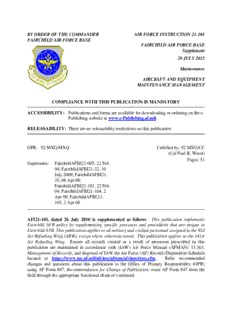
BY ORDER OF THE COMMANDER FAIRCHILD AIR FORCE BASE AIR FORCE INSTRUCTION 21 ...
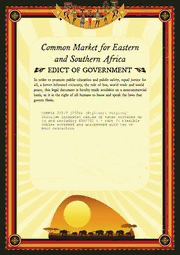
COMESA 225-7: Polyvinyl chloride insulated cables of rated voltages up to and including 450/750 V - Part 7: Flexible cables screened and unscreened with two or more conductors
![Carillon, [Spring 2006] book image](https://cdn.pdfdrive.to/media/content/thumbnails/4a9d8608-f5cb-4569-86da-81adbdb75f38.webp)
Carillon, [Spring 2006]

Replication issues in syntax-based aspect extraction for opinion mining

Духовные христиане молокане в Амурской области во второй половине XIX - первой трети ХХ вв
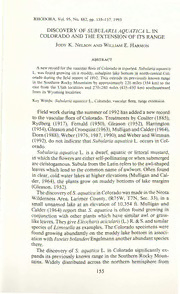
DISCOVERY OF SUBULARIA-AQUATICA L IN COLORADO AND THE EXTENSION OF ITS RANGE
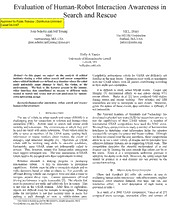
DTIC ADA456128: Evaluation of Human-Robot Interaction Awareness in Search and Rescue
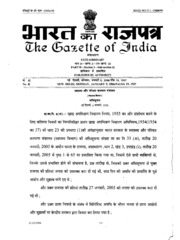
Extraordinary Gazette of India, 2006, No. 516
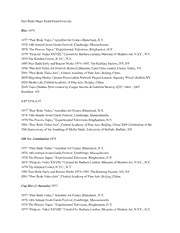
Exhibition History
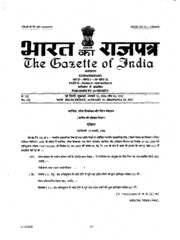
Extraordinary Gazette of India, 2006, No. 528

Byzantine Gospel Maximus the Confessor in Modern Scholarship
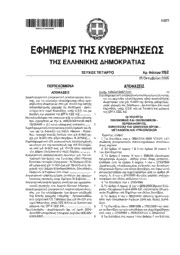
Greek Government Gazette: Part 4, 2005 no. 1152
